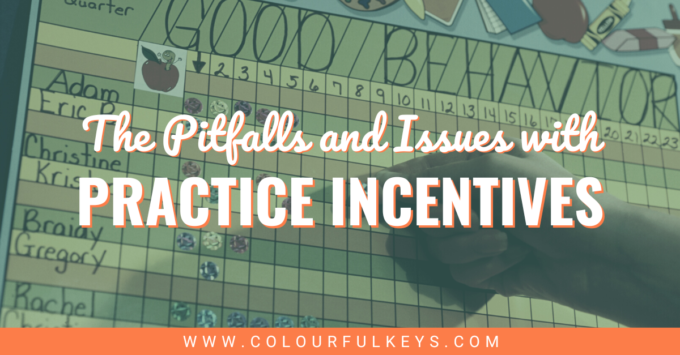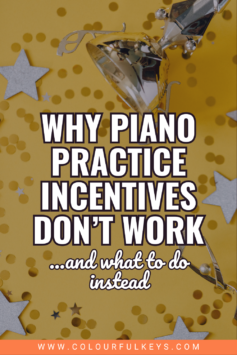Are you looking for the latest, greatest piano practice incentive of all time? Well, you’re in luck. Because in this article you’re going to find the opposite. You’re going to find out why your last practice chart failed, why the prize box didn’t work and why the next idea won’t work either.

I see you. You’re tempted to stop reading, skim down this page and then dismiss what I’m saying as codswallop and balderdash.

I get the temptation. Because what I’m about to tell you is a much bigger project than creating your next practice incentive scheme – however elaborate that scheme might be.
But let’s take the hard road for a moment, my friends. Let’s take a few minutes to step back and ask ourselves what our goals are, and how those goals could best be achieved.
The Practice Dream
What we want – every last one of us – is for our students to practise consistently. Can we agree on that?
Great. 🙌🏽
And we want that because it means our students can make great progress every week towards becoming wonderful musicians. However our definitions of “wonderful musicians” may vary, I think we can agree on that too.
So if that’s the case, our goal is not to get them to practise this week or this month. We all know that learning to play a musical instrument takes longer than a month or even a year to accomplish.
We don’t lament a student’s lack of practice (at least I hope we don’t) if it’s an exception. If they have a single “off week”, or a couple of them, in the course of a year of studies, I think most of us find that reasonable.
Where we have a problem is with students who never (or hardly ever) practise, am I right?
Practice Rewards ≠ Practice Dreams
So, hopefully we can agree that the goal is students who practise consistently for years (with some blips, since they’re humans). They come into lessons prepared and enthusiastic about the material we’re working on.
If that’s not your dream, I give you full permission to stop reading right away.

Still here? Ok, let’s take a look at why practice competitions, leaderboards, rewards, tracking, incentives and Beethoven Bucks don’t achieve this goal. 😬
Music Practice Incentive Issue 1: Reaching the Wrong Students
Imagine you’ve got three groups of students in your studio:
- About a quarter of your students practise very consistently. Their parents encourage their efforts at home and they show up to lessons ready to show you their pieces and ask you about issues.
- About another quarter practise in little fits and starts but have many off weeks during the year.
- The remaining roughly 50% almost never practise.
You’re a bit fed up with going over and over the same things with group number 3, so you decide to bring in a new practice program. It’s got a Dalmatian theme, and every week they do the number of minutes they’re supposed to, they get to add a little black dot sticker to the big white dog statue you have in your studio’s entrance area.
Most of the students seem excited about it when you tell them. It sounds really fun!
Now, once it’s up and running, who do you think sticks the most black dots on that dog?
Group number 3?
No, come on. Now we’re really living in a dream world.
Maybe in the first few weeks they do. Maybe there’s a good uptick in their practice and it gives you hope – aha, we found the magic practice elixir at last!

But it doesn’t last long for those students. And group no. 2 are largely unaffected as well. By the end of the year, the vast majority of the work in turning the plain white dog into a beautiful Dalmatian was done by group no. 1: the students who were going to practise anyway.
Music Practice Incentive Issue 2: Lessons Learned
OK…but at least we got some practice out of students that wouldn’t have practised otherwise, right?
Yep, those few weeks allowed those students to make a bit more progress than they would have if you hadn’t done anything.
But what’s the cost?
What have those students learned from the experience?
We would hope that they would learn that it feels good to put in effort and then get better at something. But, in my experience, a few weeks isn’t enough to learn that lesson for anyone but the grittiest of students. (And most of them were probably already in group no. 1; let’s be real).
The greater lesson they get to learn comes from the rest of the weeks in that year.
Let’s be generous and say that everyone kept up with their practice goals and put their triumphant sticker on the dog for the first 6 weeks. In the average studio that leaves 30 – 38 weeks left in the teaching year. That’s more than 30 weeks where they come in and have to discuss with you how they failed to practice that week.
Sure, you probably won’t use the word “failed”; you’re a lovely person after all. But even if you don’t say anything, that darned dog is there to remind them on their way in and out of the studio.

You may not be intending to punish them, but the absence of the reward that they had a little taste of for a few weeks feels like a punishment to them.
The lesson they take from that might be:
- “I’m so useless. Why can’t I practise like everyone else obviously does?”
- “I’m no good at music.”
- “I must not care much about music if I never find the time to practise.”
It breaks my heart a little just writing that. We know that’s not the reality. We know that for the most part the difference between them and the student who does practise every week is that those students’ parents help with the routine at home, and they may also have some in-built grit that helps them along too.
Music Practice Incentive Issue 3: The Cliff
Now we come to the biggest issue for me, even though it represents a smaller number of students. These are the students who you may have been screaming at me about while reading this, exclaiming that you have some students for whom a practice incentive was just the ticket. That you’ve seen firsthand that when it works, it really works.
This minority of students are completely ignited by your practice program. It took them from barely practising once, to coming in excited to show you their progress and the pieces they went ahead to work on by themselves.
Amazing, I can’t help but love that. 💜
Except…for when the magic fades. It may take three months or a year or even two. But at some point it does. I’m sure you’ve seen it.
And when it does, they’re left with an even clearer lesson than the one I outlined above:
I only practised because I was getting a reward. If I’m not getting a reward, or if I stop caring about the reward, I have no reason to practise.
Take a look at your own life and the things you do because you want to vs the things you are incentivised to do:
- Would you teach if you weren’t getting paid? Maybe, but probably not as many students as you have now, and your perspective on it would likely change.
- What about putting out your rubbish? Would you do that if you didn’t get the reward of having a clean house?
- How would you feel if someone offered to give you a coffee shop gift card to visit an elderly family member once a week? Or if your spouse offered to give you a piece of jewellery every month if you make dinner every night?
It changes the dynamic.
It’s not that rewards are never a good thing. But they don’t have a place in our hobbies and the things we learn for fun. Ask anyone who has turned their hobby into a career: It’s hard to keep the same love and lightness you had when it wasn’t responsible for keeping you alive.
Which is why these students fall off a cliff and end up with worse habits than before the practice incentive captured their imagination.

This happened to me the most dramatically with the Tonara music practice app. The app had a leaderboard which told students how their practice over the past 7 days compared to everyone else in our piano studio.
From the start I was dubious about this part of the app. I never really mentioned it to students, but some found it on their own and became really driven to increase their points and stay at the top.
We had one student for whom this worked for about 18 months. She was breezing through her method book and flying through scales. But then, she fell out of love with the points. And from that time until she eventually quit about a year later, I would be surprised if she practised more than once a month.
Lessons stagnated, progress stilled and – though we tried everything to get her back into it – the damage had been done.
The (Boring) Practice Reality
So, if practice incentives, Dalmatians and trophies aren’t going to get us anywhere, what IS the solution? 😤
The good news is that it’s simple. The bad news is that it isn’t easy.
Good practice comes from:
- Great communication with parents right from the first meeting
- Developing practice routines
- Scaling up practice efficiency once the routine is in place
- Keeping things positive even when no practice is happening
When we came to create our own music practice app, Vivid Practice, I knew I wanted to help nudge things in the right direction without giving the false hope that leaderboards and prizes will solve it all.
We built in routine reminders to encourage parents and students to commit to a routine that works for them and get notifications to help them stay on track.
Our biggest focus is on practice structure and encouraging students to practise in research-backed ways. Watch the video tour below to learn more about the Vivid Practice approach.

Have any practice incentives backfired in your studio?
I’d love to hear your experiences – good and bad – in the comments.
This was so well written! I have never really done incentives. I will hand out practice trackers over summer and long breaks and you are correct the ones I receive back are the ones who already have established practice routines.
I have found that the biggest motivation for practice is learning music they love and working toward a clear goal they have set. I also model practice strategies at every lesson. I look forward to exploring the strategies on Vivid Practice.
I am still trying to assist those students who have a legitimate reason for not practicing. I have several students who fall into this category. Your but the pieces plans and the two no practice plans have been very useful. However, some of these students are being disserviced by having to move at a slower pace. I have always dreamed of opening a studio with extra practice rooms. I would also like to include large instruments such as an organ, timpani, and mallet percussion. So many students have the passion but do not have consistent access to instruments.
We’re so glad you found this helpful, Beth! Yes, check out Vivid Practice:) And I totally understand about non-practicers. Thankfully, as you’ve discovered the VMT Library is full of resources a teacher can use to help those students. (As well as the ones who do actually practice;)